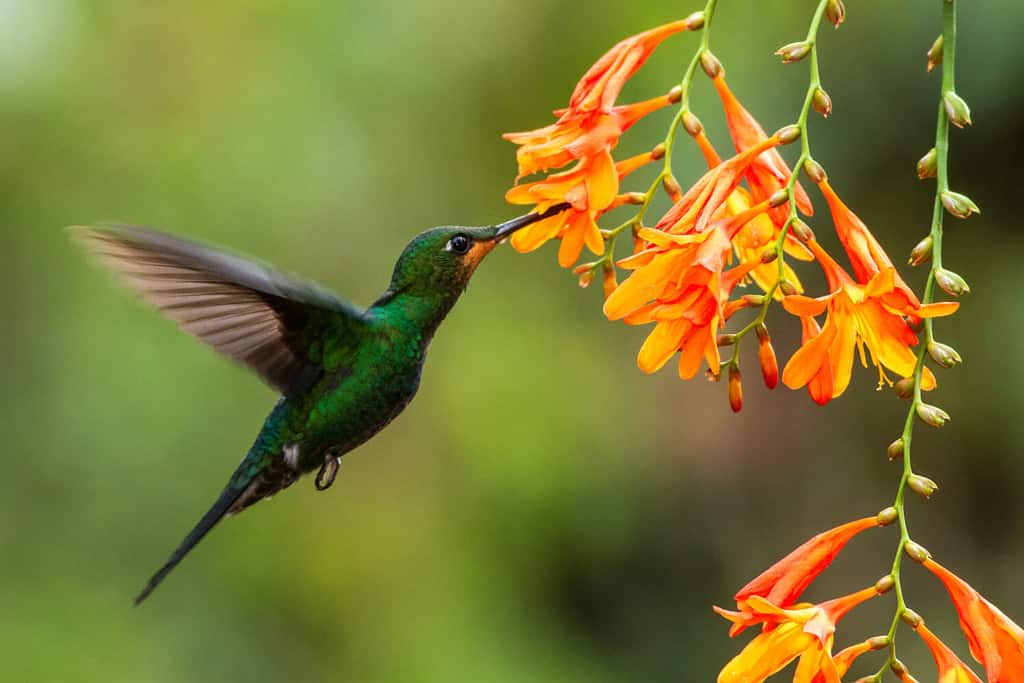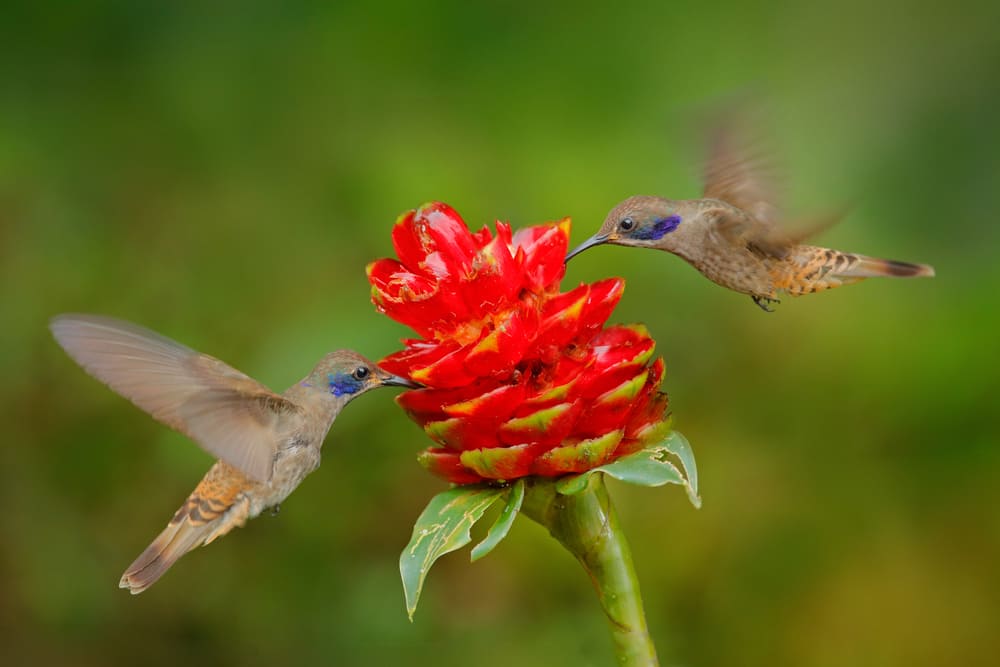Hummingbirds are an enigma, with their astonishing speed, varied body sizes, agile mobility, and astounding memory. One of its most unique traits, however, is the method that they use to eat and drink. Let’s discover how, exactly, do hummingbirds eat and drink?
How Do Hummingbirds Eat and Drink?

Hummingbirds are the second largest family of birds with over 330 species.
©Jiri Hrebicek/Shutterstock.com
Contrary to the “capillary action” theory — where liquid rises against gravity, like a straw or vacuum — when the bird sticks its tongue out, the tongue’s elasticity grabs and traps the nectar. When the bird flings its tongue back into the nectar for another taste, its tongue propels the nectar up into the throat, acting like a pump. This automatic motion requires no effort from the hummingbird but is actually a reflex of sorts.
The Old Theory — “Like a Straw”

These extraordinary birds consume about half their weight in nectar and bugs each day.
©Ondrej Prosicky/Shutterstock.com
For about 180 years, scientists and biologists adhered to what is called the “capillary theory” to explain how hummingbirds eat and drink. To simply explain this 1830s theory, let’s look at a little hummingbird biology.
The capillary theory is this: The hummingbird’s tongue is shaped like a fork. This fork-shaped tongue is coated with hair-like extensions that are called lamellae. When the tongue goes into the flower, it separates, causing the lamellae to extend outward. When the bird pulls its tongue back, the tips of the “fork” come back together. Then, the lamellae roll inward and trap the nectar within the tongue.
The idea, according to scientists, was that this tongue-stretching action extracted nectar. The surface tension of the molecules was thought to make the liquid climb up the tube walls. This tension then holds the liquid together and pulls all of the fluid column back up to the bird’s throat. Simply speaking, this action is similar to the way a straw works.
According to 19th-century experts, simple physics would propel the nectar to rise in the tongue’s tubes, thereby giving the hummingbirds that sugar-heavy elixir that fuels the birds’ incredible energy.
There were problems with the theory. One, the hummingbird’s throat grooves don’t reach its throat; consequently, the bird cannot use them as microscopic straws. Secondly, the hypothesis was so difficult to test — that it was never tested. Therefore, even though the capillary theory was a bit controversial, it was accepted for over 180 years.
The Current Theory — “Like a Pump”

Hummingbirds are definitely attracted to hydrangeas.
©R.C. Bennett/Shutterstock.com
Fast forward to the early 21st century, at the University of Connecticut. Biologists at this time were utilizing computer programs to represent what they hypothesized was going on in nature. Using the prevalent theory that they had — the capillary theory — they predicted that hummingbirds should desire nectar that was more watery than thick.
Alejandro Rico-Guevara, at the time a graduate student at UConn, doubted the scientists’ hypothesis because he knew that many birds preferred thicker, not thinner nectars. Rico-Guevara teamed up with his Ph.D. advisor, Associate Professor Margaret Rubega, to discern more, to go beyond what was written down and widely accepted.
Skepticism + Technology = Discovery

Rico-Guevara and Rubega used high-speed video at rates up to 2,400 frames per second to document the mechanics of unaltered hummingbird tongues moving in and out of nectar.
©ERIK Miheyeu/Shutterstock.com
Rico-Guevara committed to testing the precedent theory on 30 species of hummingbirds. Using high-speed video, he recorded and observed hummingbirds drinking nectar from feeders with clear walls. Slowing down the video and the clearness of the walls allowed Rico-Guevara to find something different than the “straw” theory.
He found that when the bird drank, its tubes separated from each other, like a snake’s forked tongue. The tubes inflated to expose minuscule fringes that trapped the nectar and then retracted, pulling the fluid back up the bird’s throat. This pulling action creates a pump-like effect that draws nectar into a basin at the tip of the tongue and then squeezes the nectar into the bird’s beak.
Additionally, the duo discovered significant findings about the “pump” process. During postmortem exams of the birds, they manipulated the dead birds and discovered that this pump-like way that the hummingbird eats and drinks required no energy on the bird’s part. Rather, the action was reflexive, automatic.
This hummingbird discovery could extend and provide insight into both other birds and beyond. More than 200 other bird species have tongues similar to the hummingbird’s; therefore, the “pump” process could very well extend beyond this fascinating bird.
Additionally, this unique, fluid-gathering mechanism could be advantageous to other industries. Engineering is a possible area where the process could be helpful as it could be developed to create low-energy fluid trapping, both saving money and protecting the environment.
Continuing to Inspire

Hummingbirds have long symbolized good fortune, resiliency, and recovery.
©iStock.com/Jedlovec
How hummingbirds eat and drink remained a mystery until the 1800s, when a plausible theory was introduced and accepted. Almost 200 years later, a skeptical grad student and his advisor set out to discern more about this fascinating creature. Who knows what further gems about the hummingbird remain secrets, just waiting to be unearthed?
Thank you for reading! Have some feedback for us? Contact the AZ Animals editorial team.








